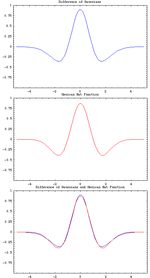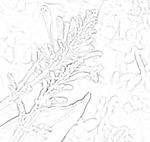- Difference of Gaussians
-
In computer vision, Difference of Gaussians is a grayscale image enhancement algorithm that involves the subtraction of one blurred version of an original grayscale image from another, less blurred version of the original. The blurred images are obtained by convolving the original grayscale image with Gaussian kernels having differing standard deviations. Blurring an image using a Gaussian kernel suppresses only high-frequency spatial information. Subtracting one image from the other preserves spatial information that lies between the range of frequencies that are preserved in the two blurred images. Thus, the difference of Gaussians is a band-pass filter that discards all but a handful of spatial frequencies that are present in the original grayscale image.[1]
Contents
Mathematics of Difference of Gaussians
 Comparison of Difference of Gaussian with Mexican hat wavelet
Comparison of Difference of Gaussian with Mexican hat wavelet
The Difference of Gaussians (DOG) is a wavelet mother function of null total sum which approximates the Mexican Hat wavelet by subtracting a wide Gaussian from a narrow Gaussian, as defined by this formula in one dimension:

and for the centered two-dimensional case (see Gaussian blur):

Details and applications
As an image enhancement algorithm, the Difference of Gaussians can be utilized to increase the visibility of edges and other detail present in a digital image. A wide variety of alternative edge sharpening filters operate by enhancing high frequency detail, but because random noise also has a high spatial frequency, many of these sharpening filters tend to enhance noise, which can be an undesirable artifact. The Difference of Gaussians algorithm removes high frequency detail that often includes random noise, rendering this approach one of the most suitable for processing images with a high degree of noise. A major drawback to application of the algorithm is an inherent reduction in overall image contrast produced by the operation.[1]
When utilized for image enhancement, the Difference of Gaussians algorithm is typically applied when the size ratio of kernel (2) to kernel (1) is 4:1 or 5:1. In the example images to the right, the sizes of the Gaussian kernels employed to smooth the sample image were 10 pixels and 5 pixels. The algorithm can also be used to obtain an approximation of the Laplacian of Gaussian when the ratio of size 2 to size 1 is roughly equal to 1.6.[2] The Laplacian of Gaussian is useful for detecting edges that appear at various image scales or degrees of image focus. The exact values of sizes of the two kernels that are used to approximate the Laplacian of Gaussian will determine the scale of the difference image, which may appear blurry as a result.
Differences of Gaussians have also been used for blob detection in the scale-invariant feature transform. In fact, the DOG as the difference of two Multivariate normal distribution has always a total null sum and convolving it with a uniform signal generates no response. It approximates well a second derivate of Gaussian (Laplacian of Gaussian) with K~1.6 and the receptive fields of ganglion cells in the retina with K~5. It may easily be used in recursive schemes and is used as an operator in real-time algorithms for blob detection and automatic scale selection.
More information
In its operation, the Difference of Gaussians algorithm is believed to mimic how neural processing in the retina of the eye extracts details from images destined for transmission to the brain.[3] [4] [5]
See also
- Marr–Hildreth algorithm
- Treatment of the difference of Gaussians approach in blob detection.
- Blob detection
- Scale-space
- Scale-invariant feature transform
- Notes by Bryan S. Morse on Edge Detection and Gaussian related mathematics from the University of Edinburgh.
References
- ^ a b "Molecular Expressions Microscopy Primer: Digital Image Processing - Difference of Gaussians Edge Enhancement Algorithm", Olympus America Inc., and Florida State University Michael W. Davidson, Mortimer Abramowitz
- ^ D. Marr; E. Hildreth (29 February 1980). "Theory of Edge Detection". Proceedings of the Royal Society of London. Series B, Biological Sciences (The Royal Society) 207 (1167): 215–217. JSTOR 35407. — Note that a difference of Gaussians of any scale is an approximation to the laplacian of the Gaussian (see the entry for Difference of Gaussians under Blob detection). However, Marr and Hildreth recommend the ratio of 1.6 because of design considerations balancing bandwidth and sensitivity. Note also that the url for this reference may only make the first page and abstract of the article available depending on if you are connecting through an academic institution or not.
- ^ C. Enroth-Cugell and J. G. Robson (1966). "The Contrast Sensitivity of Retinal Ganglion Cells of the Cat.". Journal of Physiology 187: 517–23.
- ^ Matthew J. McMahon, Orin S. Packer, and Dennis M. Dacey (April 14, 2004). "The Classical Receptive Field Surround of Primate Parasol Ganglion Cells Is Mediated Primarily by a Non-GABAergic Pathway". Journal of Neuroscience.
- ^ Young, Richard (1987). "The Gaussian derivative model for spatial vision: I. Retinal mechanisms". Spatial Vision 2 (4): 273–293(21). doi:10.1163/156856887X00222.
Categories:- Continuous wavelets
- Computer vision
- Image processing
Wikimedia Foundation. 2010.


